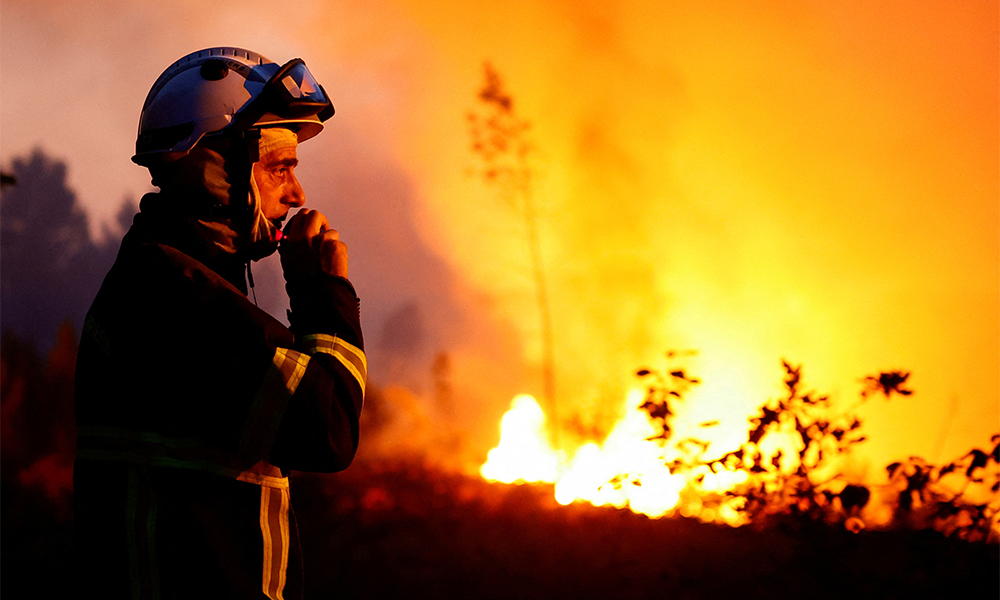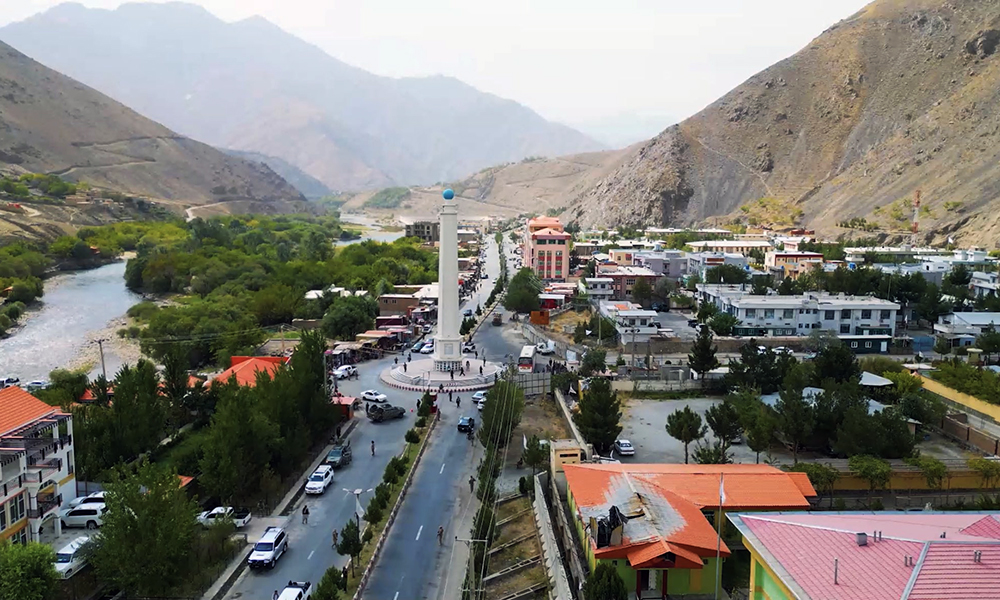Science & Technology
Europe’s heatwave reaches Poland, Greece as it moves eastwards, brings wildfires

The vast heatwave covering swathes of Europe moved steadily eastwards on Thursday, forcing countries including Italy, Poland and Slovenia to issue their highest heatwave alerts as firefighters battled wildfires across the continent, Reuters reported.
Since temperatures in southern Europe began to soar earlier this month, the heatwave has caused hundreds of deaths and sparked wildfires that have burned tens of thousands of hectares of land in countries including Spain, Portugal and France. Britain and France both saw record high temperatures on Tuesday.
According to the report the extreme heatwave is part of a global pattern of rising temperatures, widely attributed by scientists and climatologists to climate change caused by human activity. It is forecast to dump searing heat on much of China into late August.
Greece, which contained a huge wildfire that raged near Athens for two days and was fanned by high winds, urged Europe to do more to tackle climate change.
“The climate crisis is now evident across Europe, with particular intensity in the wider Mediterranean region. The cocktail of high temperatures, gusty winds and heavy drought inevitably leads to wildfires,” government spokesman Giannis Oikonomou said on Thursday.
“Europe must act in a coordinated and rapid manner to reverse the climate crisis,” Oikonomou told reporters. “The solution cannot be given at a national level, because the problem is transnational and huge.”
Greek fire fighters had tackled 390 forest fires in one week, about 50-70 blazes a day, he said. According to the meteorological station in Penteli outside Athens, where the fire broke out on Tuesday, winds reached 113 km per hour (70 mph) at one point, read the report.
Fuelled by climate change, wildfires are increasing in frequency and intensity in many countries, spreading smoke that contains noxious gases, chemicals and particulate matter and that can be damaging to health.
Reuters reported that in Poland, the authorities issued heat warnings for many parts of the country, with temperatures as high as 36.7 Celsius (98 Fahrenheit) measured in the western town of Kornik. In the northern port city of Gdansk, many residents and tourists headed for local beaches to cool down.
A large wildfire fire broke out near the southern town of Brzesko, the Onet news website reported. Firefighters told Onet that more than 50 hectares (120 acres) of fields had already burned, and that the fire was moving towards a forest.
Temperatures in Poland are expected to ease on the weekend, read the report.
In Italy, blazes in Tuscany and Friuli Venezia Giulia continued to rage but did not appear to have spread, Italian news agency ANSA reported. New wildfires were spotted in the mountains near Bologna and bordering the A9 highway, north of Milan, it said.
Fourteen cities, including Rome and Milan, were placed on the country’s highest heatwave alert on Thursday, with the number set to increase to 16 on Friday, the health ministry said.
ANSA also reported that a fire that began in northern Italy near Carso has spread across the border to Slovenia, damaging an area of over 2,000 hectares (5,000 acres).
On the Slovenian side, 400 people from three villages had to be evacuated because of the blaze, Slovenian news outlets said.
Wildfires continued to burn in Portugal and Spain.
Sitting in a large sports hall filled with cots and plastic chairs, Fernando Gimenez, 68, shed tears as he spoke about leaving his home in central Spain, west of Madrid.
Gimenez was one of thousands of residents evacuated from the village of El Hoyo de Pinares because of a wildfire.
“I don’t know what I will find. Burnt trees. Nothing. I can’t even think about it,” Gimenez told Reuters. “I feel kind of emptiness inside,” he added.
The Spanish Red Cross has organized temporary accommodation for him and hundreds of evacuees, Reuters reported.
“We work a lot with them on psychological support, because leaving their home behind without knowing what is happening, it’s hard,” said a Red Cross team leader, Belen Lopez.
Science & Technology
‘Massive cyberattack’ brings down Elon Musk’s X
Digital Trends reported Tuesday that there are reports suggesting X is still having issues

Social media platform X went down intermittently on Monday, with owner Elon Musk blaming an unusually powerful cyberattack.
“We get attacked every day, but this was done with a lot of resources. Either a large, coordinated group and/or a country is involved,” Musk said in a post on X on Monday.
He did not clarify exactly what he meant by “a lot of resources” and his comments drew skepticism from cybersecurity specialists, who pointed out that attacks of this nature — called denials of service — have repeatedly been executed by small groups or individuals.
X faced intermittent outages, according to Downdetector, Reuters reported.
Digital Trends meanwhile reported Tuesday that there are reports suggesting X is still having issues.
Internet industry experts have said X was hit by several waves of ‘denial of service’ throughout Monday.
Musk said in an interview with Fox Business Network’s Larry Kudlow the cyberattack came from IP addresses originating in the Ukraine area.
An industry source told Reuters he disputed Musk’s account, saying that large chunks of the rogue traffic bombarding X could be traced back to IP addresses in the United States, Vietnam, Brazil and other countries, and that the amount of rogue traffic coming directly from Ukraine was “insignificant.”
In any case, denial of service attacks are notoriously hard to trace back to their authors and the IP addresses involved rarely provide any meaningful insight into who was behind them, Reuters reported.
Musk has joined U.S. President Donald Trump, whom he serves as an adviser, in criticizing Ukraine’s continued efforts to fight off a Russian invasion.
Musk said on Sunday that Ukraine’s front line “would collapse” without his Starlink satellite communications service, though he said he would not cut off Ukraine’s access to it.
Science & Technology
NASA says ‘city killer’ asteroid has a 3.1 % chance of striking Earth in 2032
Despite the rising odds, experts say there is no need for alarm

An asteroid that could level a city now has a 3.1-percent chance of striking Earth in 2032, according to NASA data released Tuesday — making it the most threatening space rock ever recorded by modern forecasting.
Despite the rising odds, experts say there is no need for alarm. The global astronomical community is closely monitoring the situation and the James Webb Space Telescope is set to fix its gaze on the object, known as 2024 YR4, next month.
“I’m not panicking,” Bruce Betts, chief scientist for the nonprofit Planetary Society told AFP.
“Naturally when you see the percentages go up, it doesn’t make you feel warm and fuzzy and good,” he added, but explained that as astronomers gather more data, the probability will likely edge up before rapidly dropping to zero.
2024 YR4 was first detected on December 27 last year by the El Sauce Observatory in Chile.
Astronomers estimate its size to be between 130 and 300 feet (40–90 meters) wide, based on its brightness. Analysis of its light signatures suggests it has a fairly typical composition, rather than being a rare metal-rich asteroid.
The International Asteroid Warning Network (IAWN), a worldwide planetary defense collaboration, issued a warning memo on January 29 after the impact probability had crossed one percent. Since then, the figure has fluctuated but continues to trend upward.
NASA’s latest calculations estimate the impact probability at 3.1 percent, up from 1.6 percent last month, with a potential Earth impact date of December 22, 2032.
Richard Moissl, head of the European Space Agency’s planetary defense office, which puts the risk slightly lower at 2.8 percent told AFP that this “is not a crisis at this point in time. This is not the dinosaur killer. This is not the planet killer. This is at most dangerous for a city.”
If the risk rises over 10 percent, IAWN would issue a formal warning, leading to a “recommendation for all UN members who have territories in potentially threatened areas to start terrestrial preparedness,” explained Moissl.
Unlike the six-mile-wide (10-kilometer-wide) asteroid that wiped out the dinosaurs 66 million years ago, 2024 YR4 is classified as a “city killer” — not a global catastrophe, but still capable of causing significant destruction.
Its potential devastation comes less from its size and more from its velocity, which could be nearly 40,000 miles per hour if it hits.
If it enters Earth’s atmosphere, the most likely scenario is an airburst, meaning it would explode midair with a force of approximately eight megatons of TNT — more than 500 times the power of the Hiroshima bomb.
But an impact crater cannot be ruled out if the size is closer to the higher end of estimates, said Betts.
The potential impact corridor spans the eastern Pacific, northern South America, the Atlantic, Africa, the Arabian Peninsula, and South Asia — though Moissl emphasized it is far too early for people to consider drastic decisions like relocation.
The good news: there’s ample time to act.
NASA’s 2022 DART mission proved that spacecraft can successfully alter an asteroid’s path, and scientists have theorized other methods, such as using lasers to create thrust by vaporizing part of the surface, pulling it off course with a spacecraft’s gravity, or even using nuclear explosions as a last resort. — Agence France-Presse
Science & Technology
Panjshir will soon be connected to national fiber optic network
The statement said that this project covers a 36-kilometer route from Gulbahar to Bazarak, and the districts of Shatal, Anaba and Rukha will also benefit from fiber optic services.

The Panjshir provincial media office said in a statement on Wednesday, February 1 that practical work was to connect the province to fiber optic will begin within the next month.
The statement said that this project covers a 36-kilometer route from Gulbahar to Bazarak, and the districts of Shatal, Anaba and Rukha will also benefit from fiber optic services.
The statement added that the project is being implemented by Afghan Wireless, Afghan Telecom and ICG companies as a result of the efforts of the Panjshir provincial administration and the special attention of the leadership of the Ministry of Communications and Information Technology of the Islamic Emirate of Afghanistan.
-

 Latest News4 days ago
Latest News4 days agoAmnesty international urges Pakistan to halt Afghan deportations
-

 Latest News4 days ago
Latest News4 days agoAfghanistan-Iran-Europe railway corridor activated
-

 Business4 days ago
Business4 days agoAfghanistan ships first consignment to Europe via Khaf-Herat railway
-

 Business3 days ago
Business3 days ago36 mining contracts inked over the past year: Mines ministry
-

 Sport4 days ago
Sport4 days agoDe Kock fireworks see Kolkata thrash Rajasthan in IPL
-

 Latest News3 days ago
Latest News3 days agoDried fruit market in Herat booms ahead of Eid-al-Fitr
-

 Regional3 days ago
Regional3 days agoPowerful quake in Southeast Asia kills several, Myanmar declares state of emergency
-

 Latest News3 days ago
Latest News3 days agoUS may ask for military equipment left behind in Afghanistan: Trump
























